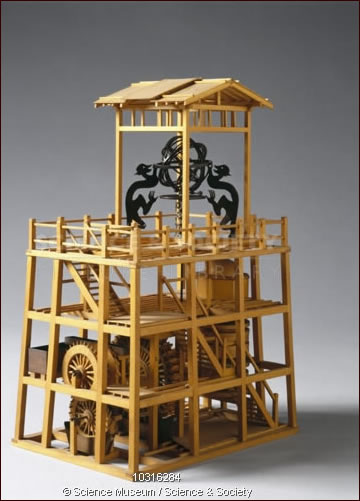Technological Advances during the Song
 |
|
Model (scale 1:48) of a Chinese astronomical clock, copied from Su Song’s New Design for a Mechanised Armillary Sphere and Celestial Globe (1092). |
|
Experimentation and Innovation
by
Song Dynasty Officials
Quite a few educated men in Song times took an interest in matters related to engineering, as well as inquiry about the physical world.
Su Song and the Mechanical Clock Tower
One high official, Su Song (1020-1101), is famous for having designed and constructed a mechanical clock tower (almost 40 feet high) by adding a chain-driven mechanism to the existing water-powered clock. The clock told not only the time of day but also the day of the month, the phase of the moon, and the position of certain stars and planets in the sky. At the top was a mechanically rotated armillary sphere that showed the changing location of the planets and stars.
Shen Gua (Shen Kuo)
Another notable polymath of the time was Shen Gua (1031-1095), who made contributions in fields as diverse as mathematics, geography, economics, engineering, medicine, divination, archaeology, military strategy, and diplomacy. In his writings Shen Gua described the use of petroleum and explained in detail how Bi Sheng first made movable type from clay. He often analyzed issues mathematically, and once computed the total number of possible situations on a game board, and another time the longest possible military campaign given the limits of human carriers who had to carry their own food as well as food for the soldiers.
Shen Gua is especially known for the explanations of natural phenomena found in his famous 11th-century book, Meng Xi Bi Tan (Meng Ch’i Pi T’an or “Brush Talk from a Dream Book”; more commonly known as the “Dream Pool Essays”).
In these pages he presents his theories on a variety of topics, including the deflection of the compass from due south:
When the point of a needle is rubbed with the lodestone, then the sharp end always points south, but some needles point to the north. I supposed that the natures of the stones are not all alike. Just so, at the summer solstice the deer shed their horns, and at the winter solstice the elks do so. Since the south and the north are two opposites, there must be a fundamental difference between them. This has not yet been investigated deeply enough. (1)
In another chapter he identifies petrified bamboo and from its existence argues that the region where it was found must have been much warmer and more humid in ancient times:
In recent years [c. 1080] there was a landslide on the bank of a large river in Yung-Ning Kuan near Yenchow. The bank collapsed, opening a space of several dozens of feet, and under the ground a forest of bamboo shoots was thus revealed. It contained several hundred bamboos with their roots and trunks all complete, and all turned to stone. ... Now bamboos do not grow in Yenchow. These were several dozens of feet below the present surface of the ground, and we do not know in what dynasty they could possibly have grown. Perhaps in very ancient times the climate was different so that the place was low, damp, gloomy, and suitable for bamboos. ... (2)
In another place Shen Gua argues against the theory that tides are caused by the rising and setting of the sun and demonstrates that they correlate rather with the cycles of the moon:
Lu Chao says that the tide of the sea is formed because it is stirred up by the rising and setting of the sun. This has not the slightest basis. If the tide were due to this cause it would have a diurnal regularity. How could it happen that it sometimes comes in the morning and sometimes in the evening?
I have myself given much study to its periodic motion, and found that the tide comes to high water whenever the moon makes its meridian transit. if you wait for this moment you will never miss the tides. ... (3)
To explain his theory about why the sun and the moon are spherical, not flat, Shen Gua wrote:
The Director asked me about the shapes of the sun and moon; whether they were like balls or (flat) fans. If they were like balls they would surely obstruct (ai) each other when they met. I replied that these celestial bodies were certainly like balls. How do we know this? By the waxing and waning (ying khuei) of the moon. The moon itself gives forth no light, but is like a ball of silver; the light is the light of the sun (reflected). When the brightness is first seen, the sun (-light passes almost) alongside, so the side only is illuminated and looks like a crescent. When the sun gradually gets further away, the light shines slanting, and the moon is full, round like a bullet. If half of a sphere is covered with (white) powder and looked at from the side, the covered part will look like a crescent; if looked at from the front, it will appear round. Thus we know that the celestial bodies are spherical. (4)
Shen Gua did not, however, realize that the sun and moon had entirely different orbits and, later in this same passage, explained that “they could meet without obstructing one another” because they were both made of qi (vital energy) and “(have) form but no solid substance.”
![]()
Notes
(1) Joseph Needham, Science and Civilisation in China, Vol. IV. Physics and Physical Technology, Part 1. Physics (Cambridge: Cambridge University Press, 1962), 250.
(2) Joseph Needham, Science and Civilisation in China, Vol. III. Mathematics and the Sciences of the Heavens and Earth (Cambridge: Cambridge
University Press, 1959), 614.
(3) Ibid., 492.
(4) Ibid., 415.
(5) Joseph Needham, Science and Civilisation in China, Vol. IV.
Physics and Physical Technology, Part 1. Physics (Cambridge: Cambridge
University Press, 1962), 2.